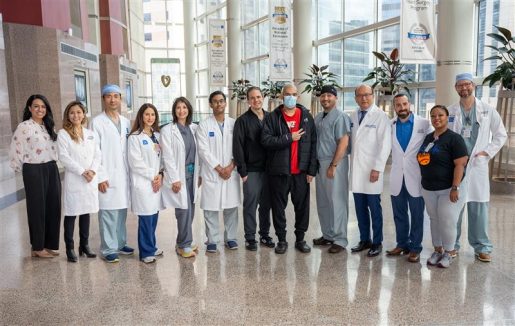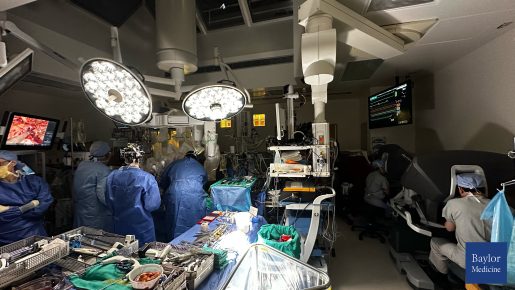Behind the first fully robotic heart transplant in the U.S.

On March 15, 2025, history was made inside an operating room at Baylor St. Luke’s Medical Center in Houston. Dr. Kenneth Liao, professor and chief of the Division of Cardiothoracic Transplantation and Circulatory Support at Baylor College of Medicine, performed the first fully robotic heart transplant ever completed in the United States. The patient was 45-year-old Tony Rosales Ibarra, a West Texas resident who had been battling advanced heart failure following a stroke in 2022.
For Ibarra, this wasn’t just a medical procedure – it was a fight for his life. After four months of hospitalization and living with mechanical heart support, he placed his full trust in his care team. “I told the doctors, ‘Do what you’ve got to do to save me. No restrictions. I want to live.”
Traditional vs. robotic heart transplant
Until now, heart transplants in the United States have required a full median sternotomy, where surgeons cut down the center of the breastbone and spread the ribcage apart to access the heart. While effective, this traditional approach comes with significant risks: larger scars, greater blood loss, higher infection rates and a longer recovery.
Liao’s approach was different. Using the da Vinci Xi Surgical System, a robotic platform designed for minimally invasive procedures, Liao and his team successfully replaced Ibarra’s failing heart without fully opening his chest.
Instead of one large incision, the surgical team worked through a series of small, precisely placed entry points. Three tiny incisions – each about a centimeter wide – were made between Ibarra’s ribs to allow the robotic instruments and camera to reach the heart. The main access point was a single 4–5-inch incision just below the ribcage (subcostal), no larger than an iPhone. This “preperitoneal” route allowed Liao to remove Ibarra’s old heart and insert the donor heart while avoiding the need to split the sternum.
How the transplant was performed
 Sitting at a console a few feet away from the operating table, Liao guided the robot’s arms with high-definition, 3D visualization and near-microscopic precision. The robotic arms were designed to mimic the movements of Liao’s hands and wrists on a smaller scale, allowing delicate maneuvers inside spaces too tight for human hands alone.
Sitting at a console a few feet away from the operating table, Liao guided the robot’s arms with high-definition, 3D visualization and near-microscopic precision. The robotic arms were designed to mimic the movements of Liao’s hands and wrists on a smaller scale, allowing delicate maneuvers inside spaces too tight for human hands alone.
Before the transplant, Ibarra had relied on mechanical circulatory support devices to keep his heart functioning. These devices were removed during surgery. Through the small chest and abdominal incisions, Liao carefully disconnected Ibarra’s failing heart from the body’s major blood vessels: the aorta, pulmonary artery and both atria. The damaged heart was gently removed through the subcostal incision.
When the donor heart arrived, it was carefully positioned inside Ibarra’s chest through that same small opening. Using a combination of robotic tools and traditional suturing techniques, the surgical team connected the donor heart to Ibarra’s existing vessels. Each connection was reinforced to ensure strength and prevent leakage, allowing for smooth blood flow once circulation was restored. The moment the heart-lung machine was turned off, Ibarra’s new heart started beating on its own.
A new standard in heart surgery
This approach offers several key benefits over traditional methods, Liao said, especially for immunosuppressed transplant patients who are at higher risk of infection. “Opening the chest and spreading the breastbone can affect wound healing and delay rehabilitation,” he explained. “With the robotic approach, we preserve the integrity of the chest wall, which reduces the risk of infection and helps with early mobility, respiratory function and overall recovery.”
Following the surgery, Ibarra’s recovery was nothing short of remarkable. He was discharged from the hospital within weeks, and by June, he began to drive, exercise and return to daily life.
For Liao, who has performed more than 1,000 robotic cardiac procedures in his surgical career, this operation represents a major leap forward in transplant surgery. “This transplant shows what is possible when innovation and surgical experience come together to improve patient care,” he said. “Our goal is to offer patients the safest, most effective, and least invasive procedures, and robotic technology allows us to do that in extraordinary ways.”
This case not only made national headlines but also marked only the second fully robotic heart transplant ever performed in the world. For patients like Ibarra, this moment signals a new era of possibilities for heart surgery.
By Kelsey Scott, communications associate in the Michael E. DeBakey Department of Surgery



